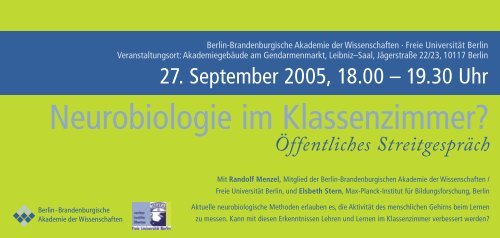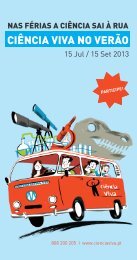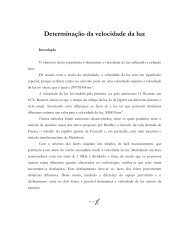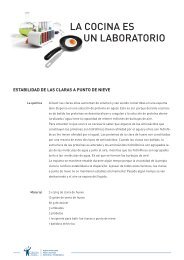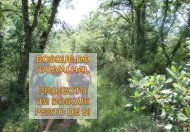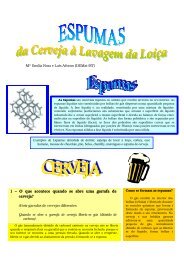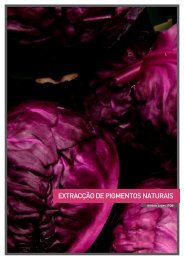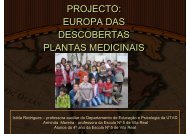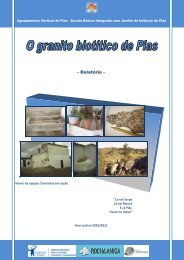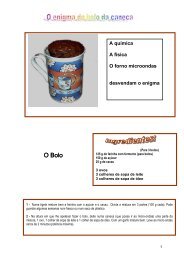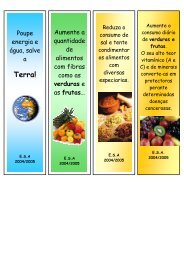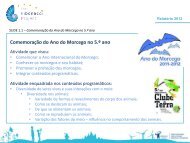Professional Development - Ciência Viva
Professional Development - Ciência Viva
Professional Development - Ciência Viva
You also want an ePaper? Increase the reach of your titles
YUMPU automatically turns print PDFs into web optimized ePapers that Google loves.
Berlin-Brandenburgische Akademie der Wissenschaften · Freie Universität BerlinVeranstaltungsort: Akademiegebäude am Gendarmenmarkt, Leibniz–Saal, Jägerstraße 22/23, 10117 Berlin27. September 2005, 18.00 – 19.30 UhrNeurobiologie im Klassenzimmer?Öffentliches StreitgesprächMit Randolf Menzel, Mitglied der Berlin-Brandenburgischen Akademie der Wissenschaften /Freie Universität Berlin, und Elsbeth Stern, Max-Planck-Institut für Bildungsforschung, BerlinAktuelle neurobiologische Methoden erlauben es, die Aktivität des menschlichen Gehirns beim Lernenzu messen. Kann mit diesen Erkenntnissen Lehren und Lernen im Klassenzimmer verbessert werden?
Neurobiologie im Klassenzimmer? findet im Rahmenvon„Science is primary – Internationale Konferenz zumnaturwissenschaftlichen Grundschulunterricht“ statt undist Teil des EU–Projektes „Scienceduc“. Veranstalter sinddie Berlin-Brandenburgische Akademie der Wissenschaftenund die Freie Universität Berlin.
Die Veranstaltung ist Teil des EU-Projektes „Scienceduc“Science is primary ist eine von sieben internationalen Konferenzen im Rahmendes EU-Projektes „Scienceduc“, die 2005 in Frankreich, Schweden, Estland,Portugal, Ungarn, Italien und Deutschland durchgeführt werden.„Scienceduc“ hat zum Ziel, „die Erneuerung des naturwissenschaftlichenUnterrichts durch untersuchendes Lernen („inquiry-based learning“) in derGrundschule“ zu fördern, d.h. durch einen naturwissenschaftlichen Unterricht,in dem die Kinder fragen, Hypothesen bilden, experimentieren, dokumentierenund diskutieren. Gleichzeitig möchte „Scienceduc“ ein internationalesNetzwerk etablieren, in dem es möglich ist, von „good practice”-Programmenanderer Länder zu lernen. Solche Programme existieren bereits in Frankreich(La main à la pâte), Schweden (Science and Technology for All) und den USA(Science and Technology for Children), wo sie von den jeweiligen Wissenschaftsakademienunterstützt werden. Ähnliche Lernmethoden werden inDeutschland u.a. in außerschulischen Laboren praktiziert, in denen sowohlGrundschulkinder experimentell arbeiten als auch zunehmend Lehrerfortbildungendurchgeführt werden.Die Berlin-Brandenburgische Akademie der Wissenschaften und die Freie UniversitätBerlin haben beide erkannt, daß der naturwissenschaftliche Unterrichtin der Grundschule verändert werden sollte. Sie laden daher gemeinsam zudieser Konferenz ein, um mit Wissenschaftlern, Politikern und Pädagogen zudiskutieren, inwieweit das untersuchende Lernen dazu beitragen kann, daßLehrerinnen und Lehrer mit Sachverstand und Freude naturwissenschaftlichenUnterricht durchführen. Dies ist die Voraussetzung dafür, daß das Niveau desnaturwissenschaftlichen Grundverständnisses und Denkens der Schülerinnenund Schüler steigt.
Berlin-Brandenburgische Akademie der WissenschaftenFreie Universität Berlin27./ 28. September 2005Internationale Konferenz zum naturwissenschaftlichenGrundschulunterrichtScienceis primary
SciencInternationale Konferenz zum natKonferenzsprachen: Deutsch und Englisch27. September 2005Begrüßung9.30 – 9.45 Detlev Ganten, Erster Vizepräsident derBerlin-Brandenburgischen Akademie der Wissenschaften9.45 – 10.00 Helmut Keupp, Vizepräsident der FreienUniversität Berlin10.00 – 10.15 Petra Skiebe-Corrette, Vertreterin Deutschlandsdes Scienceduc-Projektes / Freie Universität BerlinVorträge10.15 – 11.00 Pierre Léna, Mitglied der Académie des Sciences,Paris: „Science education with ‘La main à la pâte’: Nine years ofrenovation in France and elsewhere“11.00 – 11.30 Kaffeepause11.30 – 12.15 Smith Holt, Consultant of the National ResourcesCenter, The National Academies – Smithsonian Institution,Washington, DC: „K-9 Science Education Reform: A Model forSuccess”12.15 – 13.00 Kerstin Reimstad, Coordinator, The Royal SwedishAcademy of Sciences / The Royal Swedish Academy of EngineeringSciences, Stockholm: “The Swedish NTA program – Improvinglearning and teaching in Science and Technology”13.00 – 14.00 Imbiß14.00 – 14.45 Katharina Kohse-Höinghaus, Universität Bielefeld,Physikalische Chemie I, Gründerin des teutolab: „Informal scienceeducation in the teutolab – was Hänschen nicht lernt, lernt Hansnimmermehr“
e is primaryurwissenschaftlichen Grundschulunterricht27./ 28. September 2005Akademiegebäude am Gendarmenmarkt,Einstein-Saal, Jägerstraße 22/23, 10117 Berlin.14.45 – 15.15 Hans-Jürgen Pokall, Landesschulrat,Senatsverwaltungfür Bildung, Jugend und Sport, Berlin: „Schulische Situationdes naturwissenschaftlichen Unterrichts in der Grundschule inBerlin“15.15 – 15.45 Martin Gorholt, Staatssekretär für Bildung, Jugendund Sport des Landes Brandenburg: „NaturwissenschaftlicherUnterricht in Brandenburger Grundschulen: Erfahrungen undPerspektiven“15.45 – 16.00 Kaffeepause16.00 – 17.30 Plenardiskussion: „Can we learn from France,Sweden, and the USA to improve primary science education inGermany? – Können wir von Frankreich, Schweden und denUSA lernen, um den naturwissenschaftlichen Unterricht andeutschen Grundschulen zu verbessern?“18.00 – 19.30 Öffentliches Streitgespräch: „Neurobiologie imKlassenzimmer?“ Randolf Menzel, Freie Universität Berlin / Mitgliedder Berlin-Brandenburgischen Akademie der Wissenschaften undElsbeth Stern, Max-Planck-Institut für Bildungsforschung, Berlin(Leibniz–Saal)28. September 20059.00 – 12.30 Workshop für Lehrerinnen und Lehrer sowieInteressierte: Smith Holt -„Inquiry Science: A workshop onfloating and sinking – Untersuchendes Lernen: Ein Workshopüber das Schweben und Sinken“(Sprache: Englisch mit Übersetzung ins Deutsche)Der Eintritt ist frei. Anmeldungen bitte per Fax: 030/ 20370-599E-mail: becker@bbaw.de oder telefonisch unter 030/ 20370-583
German National Conference of the SciencEduc Program: “Science is Primary”The German national conference was held on the 27th and 28th of September 2005and was organised by Dr. Petra Skiebe-Corrette (German representative ofSciencEduc, Freie Universität Berlin) in cooperation with the Berlin-BrandenburgAcademy of Sciences and Humanities (Dr. Karin Elisabeth Becker, responsible forinternational relationships at the Academy). The Academy is located in the center ofBerlin, so the conference was held in the lecture halls at the Academy. The invitedparticipants in the conference included primary school principals and teachers,scientists, and people working in the school administration. The conference wasopened by Dr. Skiebe-Corrette as the German representative of SciencEduc, thevice president of the Freie Universität Berlin Prof. Helmut Keupp, and Prof. RandolfMenzel representing the Berlin-Brandenburg Academy.In order to inform the German public about the best practice model programs existingin Europe and the USA which use inquiry-based learning to teach science,representatives of three of such programs were invited by Dr. Skiebe-Corrette to givea presentation at the conference:- Prof. Pierre Léna (Mitglied der Académie des Sciences, Paris): La main à la pâte- Kerstin Reimstad (Coordinator, Science and Technology for All Program, TheRoyal Swedish Academy of Sciences/ The Royal Swedish Academy ofEngineering Sciences, Stockholm): Science and Technology for All- Prof. Smith Holt (Consultant of the National Science Resources Center, TheNational Academies–Smithsonian Institution, Washington DC): Science andTechnology for Children.In Germany, inquiry-based learning of children is often found in informal sciencelaboratories, which also play an increasing role in teacher training. Prof. KatharinaKohse-Höinghaus (Universität Bielefeld, Physikalische Chemie I, head of the informalscience laboratory teutolab) represented one of the over 100 existing informalscience laboratories. The teutolab was one of the first informal science laboratoriesfounded and was one of the first to focus on primary school pupils.In order to involve the federally organised school system in Germany, tworepresentatives from different federal states (Berlin and Brandenburg) were alsopresent, reporting on the status of science teaching in their primary schools:
- Hans-Jürgen Pokall (Landesschulrat, Senatsverwaltung für Bildung, Jugend undSport, Berlin)- Jürgen Hegemann (Leiter der Abteilung Schulaufsicht, Qualitätssicherung undWeiterbildung, Ministerium für Bildung, Jugend und Sport des LandesBrandenburg, Potsdam)The individual talks were followed by aplenary discussion with Prof. Menzel, Prof.Kohse-Höinghaus, Kerstin Reimstad, Prof.Holt (from left to right)and was lead by Dr.Skiebe-Corrette.The first day of the conference was closed with a public debate between Prof. Menzeland Prof. Stern (Max Plank Institute for Human <strong>Development</strong>), who argued the proand con of using the results of neuroscientific research in the classroom. Followingthis debate, some of the speakers and organisers (Prof. Holt, Kerstin Reimstad, Prof.Menzel and Prof. Kohse-Höinghaus, Prof. Stern, Dr. Skiebe-Corrette, Dr. Corrette)attended a conference dinner at a nearby restaurant to discuss how inquiry-basedscience teaching can best be implemented in the future in Germany.One the first day, the conference was attended by 55 participants including:- 21 teachers from 19 different primary schools- 10 researchers involved in science education from various institutions (IPN in Kiel,ZNL in Ulm; Primary science education, University of Kassel; Max-Plank-Institutfür Bildungsforschung; Didaktik der Chemie, FU; Didaktik der Physik, FU; Didaktikder Biologie, FU; Didaktik der Physik, Humboldt Universität, Primary scienceeducation, FU)- 6 representatives of public foundations (Telekom Stiftung, Robert Bosch Stiftung,McKinsey & Co. Inc.)- 5 representatives from informal school laboratories (DeutschesElektronensynchoton, NatLab - Freie Universität Berlin, Freilandlabor Kaniswall)
The aim of the second day of the conference was to give an example of how inquirybasedscience education can be implemented in the classroom. Therefore, a handsonworkshop was held on the topic “floating and sinking” using materials which weredeveloped in the USA by the National Science Resources Center and which wereadapted for use by the Swedish Science and Technology for All Program. Theworkshop was taught by Prof. Holt in cooperation with Kerstin Reimstad and wastranslated into German by Dr. Skiebe-Corrette.One the second day, 33 participants attended this workshop including:- 24 teachers from 20 different primary schools- 6 researchers involved in science education from various institutions (ZNL in Ulm;Didaktik der Physik, FU; Max-Plank-Institut für Bildungsforschung; Primaryscience education, Humboldt Universität; Didaktik der Physik, HumboldtUniversität, Primary science education, FU)- 1 representative of a private foundation (Telekom Stiftung)- 2 representatives from informal school laboratories (NatLab - Freie UniversitätBerlin, Freilandlabor Kaniswall)An interview with Prof. Menzel relating to the conference was broadcast by a Berlinradio station (RBB Inforadio, “Wissenswerte”) prior to the conference. Following theconference, two newspaper articles were published (Tagesspiegel, October 4th;Neues Deutschland, September 30 th ).Due to the positive feedback from primary school directors and teachers, a secondworkshop sponsored by SciencEduc is being planned to further inform the schoolsinterested in being part of a pilot program.
Attachments:- pdf of the invitation- pdf of conference talks from Prof. Holt- pdf of conference talks from Kerstin Reimstad,- pdf of conference talks from Prof. Kohse-Höinghaus (not to be used for theinternet)- pdf of conference talks from Dr. Skiebe-Corrette
Science is primary(27. –28.9.2005)
Scienceduc(Nov. 2004 – Oct. 2006)Renovation of science teachingin European primary educationwith inquiry methodsPetra Skiebe- CorretteFreie Universität Berlin
The inquiry-based methodenhances children’s critical thinking skills by- questioning- planning / conducting experiments- making observations- data interpretation- results communication(written/oral expression)-team workGoals- Dissemination of bests practices- in the frame of formal education system- through establishment of aEuropean network
EuropeanWorking programSummer Schoolfor trainersSicily, 9-14 July 2005CoordinationIntegrationTeacher’strainingSCIENCEDUCOn lineprojectsEvaluationDissemination7 National conferences (2005)and1 European Conferenceon Primary science education(Sweden 2006)
PartnersLa main à la pâte(France)Professor Pierre LénaErasmus medal of the Academia Europaea.For a sustained, internationally recognisedcontribution to European scholarshipAssociate Partners
PartnersLa main à la pâte(France)Natural Scienceand Technology for All(Sweden)Kerstin ReimstadtAssistant project managerNational Science Resource Center(USA)Prof. Smith HoltSenior Scientist/ConsultantTeutolab(Germany)Prof. Katharina Kohse-HöinghausProfessorin für Physikalische Chemie
PartnersLa main à la pâte(France)Associate PartnersNatural Scienceand Technology for All(Sweden)Tartu University(Estonia)Apor Vilmos Catholic College(Hungary)Ciência <strong>Viva</strong>(Portugal)Consortium InnovationTraining Educational Inquiry(Italy)Freie Universität Berlin(Germany)
PartnersLa main à la pâte(France)Associate PartnersNatural Scienceand Technology for All(Sweden)Tartu University(Estonia)Apor Vilmos Catholic College(Hungary)Ciência <strong>Viva</strong>(Portugal)Consortium InnovationTraining Educational Inquiry(Italy)Freie Universität Berlin(Germany)
12 European partners with unique expertiseÉcole Normale Supérieure (France)Université Libre de Bruxelles (Belgium)University of Tartu (Estonia)Freie Universität Berlin (Germany)Consortium Innovation Training Educational Inquiry (Italy)Universiteit van Amsterdam (Netherlands)Ciência <strong>Viva</strong>-Agencia Nacional para a Cultura Científica e Tecnológica (Portugal)P.A.U. Education (Spain)Royal Swedish Academy of Sciences (Sweden)University of Leicester (United Kingdom)Apor Vilmos Catholic College (Hungary)S¡tátny pedagogick ústav - National Institute for Education (Slovakia)In collaboration with several national science academies.
12 European seed citiesSaint Etienne (France)Brussels (Belgium)Tartu (Estonia)Berlin (Germany)Perugia (Italy)Noord-Holland Noord (Netherlands)Sacavém (Portugal)Girona (Spain)Distributed (Sweden)Leicester (United Kingdom)Vac (Hungary)Ljubljana (Slovakia)Goal- Implement inquiry-based scienceeducation in a few partner schools- by teacher training- providing the teaching material- involving of the science community
Thank youSome children will be scientistsall will be citizens
PartnersLa main à la pâteAssociate PartnersNatural Scienceand Technology for AllPromote inquiry-basedteacher trainingTartu UniversityApor VilmosCatholic CollegeIntroduce inquiry-basedlearning into the classroomCiência <strong>Viva</strong>Provide teaching materialsto help teachersConsortium InnovationTraining Educational InquiryFreie Universität Berlin
Science andTechnology forAllBerlin, 2005September,27www.nta.nuKerstin Reimstad,kerstin.reimstad@linkoping.se
The presentation:• A short background – the Swedishschoolsystem, situation of science education•The role of the academies•What are the components of the NTA program?•The organization, the strategy for developmentand infrastructure•The NTA program in one of the participatingmunicipalities – Linköping•What has the NTA program contributed to?
The Swedish educational systemCompulsory basic schoolK- grade 9Upper secondary schoolAlmost 100 % of thestudentsHigher educationAbout 38 % of the students
Compulsory schoolK-grade 9Sweden has a decentralised schoolsystem.In Sweden the state governs educationthrough a series of statues,government orders, the nationalCurriculum and SyllabusesEveryone working in the school system isobliged to work towards common goalsand objectives, thereby guaranteeingeducation of uniform value.Both the school and the individual teacherare responsible for deciding how to workin order to reach the goals set.
The syllabuses… establish the subject´sgeneral orientation and nature, the goals for thesubject and the goals to be attained by studentsin the fifth and ninth grades.The individual teacher decides which topicsshould be covered in lessons, the appropriateteaching methods and the materials to be used.There are goals to aim for and goals toattain.At each school and in each class, theteacher must interpret the nationalsyllabuses and together with thestudents plan and evaluate teachingon the basis of the student´spreconditions, experiences, interestsand needs.
Goals that pupils should haveattained by the end of the fifth year inschoolConcerning scientific activity•Pupils should have their own experiences ofsystematic observations, measurements andexperimentsGoals that pupils should haveattained by the end of the ninth year•Pupils should be able to make measurements,observations and experiments, as well as havean insight into how they can be designed.
Swedish education system– Municipalities responsible forcompulsory school since 1994.– S & T in the national curriculum andsyllabuses for elementary schoolsince 1994– Schools and municipalities badlyprepared• most Elementary teachers have noformation in S & T– Schools have difficulties meetingthe goals in the national curriculumand syllabuses in S & T
Swedish education systemcontinued...Conclusions:– Much too few young people chosea higher education in S&T– Compulsory school has largedifficulties in living up to theNational Standards in S&T–This• makes it very hard to meet the demandfrom industry and society for well trainedemployees• is detrimental for the civic scientificliteracy• may be a very serious threat to thedemocratic process and damaging for asound and balanced culturaldevelopment.
What´s in it for the Academies?The Royal Swedish Academy ofSciences and The Royal Academyof Engineering Sciences have asone of their missions to promotethe development of science andtechnology in society.In thiscontext, the school is a veryimportant collaborative partner.
The role of Swedish academies• The crises in S&T teaching was wellrecognized by the Royal SwedishAcademy of Science (RSAS) in thelate 1980s.– While very interested in S&T in firstgrades, a majority of students in latergrades seemed to have lost theirinterest.– RSAS took several measures includingconferences and teacher prizes• News from NSRC reached RSAS in1994 and an agreement to introduceSTC in Sweden was signed in 1996.
The role of Swedish academiescont...• Enthusiastic response from fieldtests indicate that NTA/STCseems an ideal model to improveS&T teaching in Sweden.• It gives the academies a uniquepossibility to contribute to thedevelopment of the compulsoryschool.• This is central for the ultimate aimof the academies to promotenatural science andunderstanding of technology inthe society.
NTA - A Swedish SchoolProgram for Science andTechnology• Local development of science andtechnology teaching in theSwedish elementary school• The Royal Swedish Academies ofSciences and EngineeringSciences in cooperation with:– Municipalities and Schools– Higher Education– Corporate– US National Academy of Sciences(NAS)/ National SciencesResources Center (NSRC)
• NTA in Sweden is organizedaround a number of componentsthat were inspired by the NSRC.– Curriculum development– Organized material supportsystems– Continuous professionaldevelopment– Building administrative andcommunity support– Assessment of student´slearning
NTA - A Swedish SchoolImprovement Program• The aim of the NTA program is tosupport teachers in their effort tostimulate children´s and youngpeople´s curiosity, interests andknowledge in science andtechnologyBy developing metods for localimprovement in teaching and learningand spreading them to municipalitiesand independent schools in Sweden.
NTA Expansion1997: 1 municipality, 1,200students, 60 teachers2003: 34 municipalities, 4independent schools2004: 45 municipalities, 9independent schools,40,000 students, 2,200teachers
NTA:s program forschool developmentAdministrative andcommunity support<strong>Professional</strong><strong>Development</strong>NTA units including material for experiments andguides for students and teachersOrganized MaterialSupport SystemsEvaluationNetworks
Grade123456NSRCsScience and Technology for Children units (STC)OrganismsThe Life Cycleof ButterfliesPlant Growth and<strong>Development</strong>Animal StudiesMicroworldsExperiments with Plants**WeatherSoilsRocks andMineralsLand and WaterEcosystemsMeasuring Time*Solids and LiquidsChangesChemical TestsElectric CircuitsFood ChemistryMagnets andMotors****** *Comparing andMeasuringBalancing andWeighingSoundMotion and DesignFloating and SinkingThe Technologyof Paper****Properties of Matter( Middle School)
NTA-quality of services and productsThe quality of the NTA program built inproducts and services assumes the nationalcurriculum and the syllabuses in biology,chemistry, physics and technology. Theguidelines work as means for control in the NTAprogram on a national level as well on thecentral and on the school level in eachmunicipality.1. NTA shall stimulate curiosity aboutscience and technology both for childrenand their teachers2. NTA shall encourage responsibility,learning and language development bothfor children and their teachers
Organized MaterialSupport System
<strong>Professional</strong> developmentprograms•Teachers•Trainers•Local coordinators andadministrators from themunicipalities
<strong>Professional</strong> development for the techers•Introductory training•Unit training•On-going professional development-exchange of experience in teachernetworks-study groups about science content-reflection and discussion on workingmethods and forms
Cources at university level•Science and Technology•Physics –how things work•Scientific concepts and phenomena
Forum for dialoguesForum for exchange
Linköping universityEvaluation- the NTA programConclusions:•The students and the teachers learnscience and many become interestedin the subject area.•NTA can provide a platform for bothstudents and teachers to developscientific knowledge•The NTA material is not sufficient, therole of the teacher is important•<strong>Professional</strong> development for theteachers is very important
Students interests and attitudes”Has the pupils´interest in science andtechnology increased?”•Yes, you could see they didn´t want tostop today. (Teacher, grade 6)•Yes, a general interest in science inboth girls and boys has been the result.(Teacher grade 4)
•”I´ve learned how light bulbs shouldbe connected. I ´ve learned that ifyou have a light bulb and twobatteries the bulb glows verybrightly.”•”If you have a bulb and only onebattery?”•”It glows weakly”•”Do you have to think aboutanything special when you´reconnecting bulbs and batteries?”•”Yes, you have to do it right.”•”What do you have to keep inmind?”•”You have to think …(draws adiagram) that this is a bulb and thisis a battery. A round ring with across is a bulb and a line is a wireand you put a wire here and a wirehere.
•Working with predicitions is what I´mgood at. That´s what´s fun.(Girl grade 6)•Testing things is fun ( Girl grade 6)•Doing practical experiment is fun.(Girl grade 6)•It´s fun to work in groups and weighand check things.(Boy grade 6)•It´s fun when you light lamps withbatteries and stuff like that.(Boy grade 6)•Testing predictions is great I think(Girl grade 5)
I´ve learnt a lot. I´ve become morestructured. I have learnt how to build uponthings you´ve already done and learnt tosee what is suitable for use in primaryclasses. At the start I did such thingsspontaneously. I feel that this has given methe knowledge to structure things.(teacher, grade 6)Yes, I have. A lot is about daring to teachthings I´m not too sure about. And then I´vehad my own Eureka experiences aboutscience.(teacher, grade 4)
Guides for the teachers are seenas an important aid and a source ofknowledge for the teacher wishingto develop his/her competence.Do you read the teachers´guidescarefully?•Yes, I do that so that I can adapt it.You can´t just read stuff and use itstraight off. (Teachers grade 4)•For me there is security in theteachers´guides since I´m nottrained in science. I don´t knowwhich elements we should beinvestigating. It´s good thatsomeone else has done the workfor me. (Teachers grade 4)
Before NTA came along there wasn´tmuch science in school. This has meantthat everyone is tackling science now.(teachers, grade 4)
NTA:s program forschool developmentAdministrative andcommunity support<strong>Professional</strong><strong>Development</strong>NTA units including material for experiments andguides for students and teachersOrganized MaterialSupport SystemsEvaluationNetworks
Organization from 2004-01-01Board for NTAProduction andServiceMembers wouldincluderepresentatives of themunicipalities as wellas KVA and IVAScientific Council for NTA<strong>Development</strong>Members would includerepresentatives of KVAand IVA as well as themunicipalitiesNTA Production andServiceOwned, run and financed bythe municipalitiesProvides/sells complete unitmaterial, instructions forNTA units, training for unitinstructors and coordinators·NTA <strong>Development</strong>Run in project form andfinanced by KVA and IVAAdapts and developsextant and new unitsDevelops servicesDevelops an infrastructurefor didactic research inscience and technology
NTA´s strategy for schoolimprovementNTA offers and develops services andproducts for school improvement bothat the central municipal level andat the level of individual schools/ schooldistrictsCentral municipal levelKey functions: NTA-coordinators and materialsupportAt the level of a schoolKey functions: School administrators and aNTA contact person
The process when a municipality becomes amember.OctoberInformation about the NTA program for interestedmunicipalitiesNovemberApplications from the municipalitiesDecemberThe municipalities are accepted as membersJanuaryThe planning and strategy work start in themuncipalitiesFebruaryNTA Production and Services visit the municipalities
MarchConference for all NTA-coordinatorsApril- SeptemberContinuous planning in the mun.<strong>Professional</strong> development forteachersAugustThe pupils and teachers startworking with NTA unitsOn-going professional developmentNovemberRegional conferences for NTAcoordinators
Linköping
The coordinator of the municipalityMaterial supportTeam ofteachersAssessment<strong>Professional</strong> developmentNTA units
The coordinator of the municipalityPartnership with local industryCooperations withother municipalitiesWebsitesMaterial supportTeam ofteachersAssessmentNetworks with otherteachers<strong>Professional</strong> developmentNTA units (the curriculum)Partnership with the local universityEvaluation
NTA-teachers, who have worked with sevenNTA-units”The changed approach to science andtechnology is the most important thing we´velearnt.””The general level of competence hasimproved and less anxiety among theteachers.””More of What- and Why-questions.””It´s a case of daring to let go and letting theimagination and the creativity of the studentstake over.”
”We have learned that our students can takeon more of a challenge than we previouslyimagined.””The students are capable of morethan we thought- provided that we, adults,show them respect.””We are now more anxiousto listen, to communicate, to each student.”
What the NTA program has contributed to thelearning environment of students and teachers inthe municipality of Linköping?•An increased eagerness to study science•Teachers have changed their approach tolearning and teaching science and technology,they have learnt more science and they havedeveloped their working methods•Access to a model for school improvement•The implementation of NTA in schools forchildren with special needs•Extanded networks among the teachersKindergarten-grade 9•A very positive response from parents•Partnerships with local businesses•Networks with other municipalities in the NTAprogram
Taken together NTA is a system approachfor promoting local developmentNot just ready-made suggestions abouthow to teachNTA is an organized forum for an ongoingdiscussion about learning andteaching in science and techonologyinvolving teachers and their students,school administrators, politicians,scientists, engineers, members of theacademies and education researchers
Why is the NTA program a success in Sweden?•The role of the academies•NTA:s strategies for school improvement builton the NSRC:s model for reform.•Interest and engagement from teachers,school administrators … to improve learningand teaching in science•The students and the teachers learn science•NTA is an organized forum for an on-goingdiscussion about learning and teaching inscience and technology …•The NTA units•Support and engagment from industry andbusiness-Scania, SAAB, Ericsson, StoraEnso…•Partnerships with higher education• …
Special challenges•The expansion of the NTA programtobuild capacity•The municipalities need to improveteachers´on-going professionaldevelopment. Teachers need moreopportunities to learn science andtechnology•The work of local coordinators iscritical and need further support•The adaptation of the STC-units istime-consuming•Engage industry both on a local andon a national level•…
Paul Gardner“The first task and central purpose of scienceeducation is to awaken in the child, whether ornot he/she will become a professional scientist,a sense of joy, the excitement, and theintellectual power of science.”The main field of activity for teachers is thestudents´ thoughts, ideas, perceptions,…
National Science Resources CenterSmithsonian InstitutionNational Academies© NSRC, 2005
Discussion Points1. What is the context that needs to be consideredfor those working to reform science education?2. What lessons has the NSRC and its partnerslearned from their two decades of work to reformscience education and how has this related to theneeds of the science workforce?3. Based on these experiences, whatrecommendations would we make?
Majority of people that do notvalue science and teachingThere is a decline in interest inscience and engineering amongstudents in the WestTextbooks that are notrepresentative of nor do theyfoster an interest in scienceMajority of reformers reinventingprograms that are not based onresearch and best practicesContext
Context– 25% of the current science and engineeringworkforce is more than 50 years old and willretire by the end of the decade.Source: National Science Board– The number of university students inengineering and physical sciences has declinedby 25% (1980-2004).Source: U.S. Department of Labor– The number of jobs requiring science degreesare growing at three times the rate of otherjobs.Source: U.S. Department of Labor
ContextChange in skills needed by business1. A high capacity for abstract, conceptualthinking.2. The ability to apply that capacity for abstractthought to complex real-world problems—including problems that involve the use ofscientific and technical knowledge—that arenonstandard, full of ambiguities, and have morethan one right answer.3. The capacity to function effectively in anenvironment in which communication skills arevital – in work groups.Ray Marshall and Marc Tucker,Thinking for a Living
National Science Resources CenterEstablished in 1985 as an organizationof the National Academies and theSmithsonian Institution
– Established in responseto the report “A Nation AtRisk”Background– Mission is to improvestudent performance inscience in schooldistricts in the U.S. andthroughout the world– Strategy is to use the twomost prestigiousscientific institutions toleverage change in schooldistricts
National Science Resources CenterCore Principles1. All students can learn science and shouldbe participating in effective K-12 scienceprograms.2. Strategies are based on theory of action,systems thinking, continuousimprovement, and strategic partnerships.3. Products and services are informed byresearch and incorporate best practices.4. Evaluation of the quality and impact ofproducts and services is a standardcomponent of all work.
NSRC Science Education ReformTheory of ActionIncreasedStudentAchievementImprovedInstructionEstablishment ofSchool District Infrastructure<strong>Development</strong> of Vision of EffectiveScience Learning and TeachingKnowledge of Research and Best Practices
NSRC Science Education Systemic Reform Modelfor the Establishment of School District InfrastructureNSRCResearchbasedCurriculum<strong>Professional</strong><strong>Development</strong>Vision of EffectiveScience<strong>Professional</strong> Learning and <strong>Development</strong>TeachingScienceMaterialsSupportAdministrativeandCommunitySupportAssessment
<strong>Professional</strong><strong>Development</strong>CenterNSRC Centers of ExcellenceLeadership andAssistance forScience EducationReform CenterCurriculum<strong>Development</strong>CenterNSRC
Five Elements of ReformResearch-based TeachingMaterialsProduced through a careful Research and <strong>Development</strong> Process• <strong>Development</strong>ally Appropriate• Inquiry-Centered• Provides Hands-on Experiences withScience and Technology• Based on the National ScienceEducation Standards
Goals for Science LearningHelp students develop scientificreasoning skills and the ability tosolve practical problems.Contribute to students conceptualunderstanding of the world aroundthem.Foster the development of scientificattitudes.
Curriculum <strong>Development</strong>CenterDevelops anddisseminatesresearch-basedcurriculumprograms andsupplementarymaterials
NSRC Curriculum <strong>Development</strong> Center– STC units (24)• Revised Teacher Guides• Completed 12 new Story Books (Grades 4-6)• Preparing new storybooks (Grades 1-3)– STC/MS units (8)• Preparing new storybooks (Grades 7-9)
2005 Edition of STC Program• Unit Storylines• Literacy and WritingSections• Assessment Strategies• Resources forTeachers and Students• Safety• Sturdy D-Ring Binderwith 8 Sections
Science and Technology forChildren® Book Series• 12 books, grades 4-6• 64 page soft cover, nonconsumable• Age appropriate• Research–based• Reinforces concepts• High interest non-fictionstories andinformational articles
Five Elements of ReformAssessmentStrategies that align the evaluationof student performance with thegoals of an inquiry-centered scienceprogram.
Student A - Pre-testBee Drawing CheckList• six legs• three body parts• legs attached to middlesegment• antenna• stinger• hair on legs• double sets of wings• five eyes• other valid point .
Student A - Post-testBee Drawing CheckList• six legs• three body parts• legs attached to middlesegment• antenna• stinger• hair on legs• double sets of wings• five eyes• other valid point .
Student B - Pre-testBee Drawing CheckList• six legs• three body parts• legs attached to middlesegment• antenna• stinger• hair on legs• double sets of wings• five eyes• other valid point .
Student B - Post-testBee Drawing CheckList• six legs• three body parts• legs attached to middlesegment• antenna• stinger• hair on legs• double sets of wings• five eyes• other valid point .
Five Elements of Reform<strong>Professional</strong><strong>Development</strong>Programs that prepare educatorsto teach inquiry-centered scienceand that consider professionalgrowth as a long-term process.
<strong>Professional</strong> <strong>Development</strong>CenterProvidesproducts andservices toteachers seekingscience contentand pedagogicalknowledge
PD Center Products & ServicesFocus on Middle and Elementary Schools• Overview and Awareness Sessions (2 – 4 hrs)• STC/MS Module Implementation Courses (18 – 21 hrs)• Module specific “advanced” teacher and teacher leader courses(18-21 hours)• Enhancement courses (STC/MS and General)– The Nature of Inquiry (6 hrs)– The Use of Computer and Probeware Technology with STC andSTC/MS (10 hours)– Notebooking to improve writing/reading proficiency (4 – 6 hrs)– Integrating Literacy Strategies into STC and STC/MS (2 – 4 hrs)– Leadership (TIPDIs) one week training + ~ 200 hr PD to be certified• Content Courses, grades 4-6 and 7-9 for Graduate Credit (2 weeks)Forces, Energy, and Motion; Properties of Matter; ElectricCircuits; Light and Optics; The Human Body; OrganismDiversity; Geology; Astronomy• Museum-based “Summer Academies” (1 week)
What factors should beconsidered in implementingprofessional development programsfor teachers of science?
What factors should beconsidered in implementingprofessional development programsfor teachers of science?Researchabout learning
• Need to apply knowledge and skills to new problemResearch on How People Learn• Need to draw out and work with preexistingunderstandings that both students and teachersbring to learning• Need to learn some subject matter indepth providing many examples in which the sameconcept is at work and providing a firm foundationof factual information• Need to learn metacognitive skills
What factors should beconsidered in implementingprofessional development programsfor teachers of science?Researchabout learningResearchabout effectiveteaching
What do teachers need to know andbe able to do?LearningTeachingKnowledge about research re how people learnPedagogical content knowledge about inquiry and designKnowledge about motivationConceptual knowledge of scienceKnowledge of how to use multiple representations of contentKnowledge of how students read and write for conceptual understandingndingKnowledge about effective instructional materials and technologiesesSkill in using collaborative learning techniquesCapacity to work collectively and reflect on practice with other teachersAssessmentKnowledge of how to teach students to assess and monitor their learning lKnowledge about how to effectively use formative assessments of learning
Assessment of ExpertisePROGRESSIONEXPERTCOMPETENTNOVICENSRC
<strong>Development</strong> of ExpertiseCONTINUUMEXPERTCOMPETENT---COMPETENT---COMPETENTNOVICE ----NOVICE ------ NOVICELEARNING TEACHING ASSESSMENT
Stages of ExpertiseNovice• Lacks familiarity with practiced routines.• Performs tasks that are context-free.• Behaves rationally with little flexibility.
Stages Stages of of Expertise ExpertiseCompetent• Uses instructional strategies that begin tohelp students develop conceptualunderstanding of science concepts whiledeveloping critical-thinking and problemsolvingskills• Makes conscious choices about what toteach.• Sets priorities, goals, and plans.• Delivers reasonable instruction.
Stages of ExpertiseExpert• Has comprehensive knowledge of factualinformation about a science discipline andinquiry• Understands the relationship of factualinformation to science concepts• Can efficiently use and acquire newinformation about important scienceconcepts
Five Elements of ReformScience MaterialsSupportCost-effective systems forsupplying science equipment andmaterials to classrooms.
Five Elements of ReformAdministrative &Community SupportStrategies for building andsustaining district and communitysupport.
Stages of WorkIncreasing Time, Resources, ComplexityInitiation PhaseImplementation PhaseInstitutionalization PhaseNSRC
NSRC Webwww.nsrconline.org


